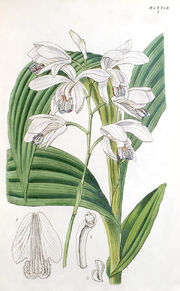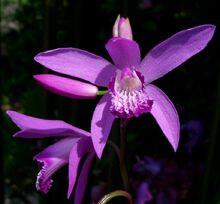| Bletilla striata | |||||||||||||||||
|---|---|---|---|---|---|---|---|---|---|---|---|---|---|---|---|---|---|
| |||||||||||||||||
Bletilla striata is the most common form found in the nursery trade and is often labeled simply as 'Hardy Orchid' or 'Chinese Ground Orchid' and is quite inexpensive.
Description[]
This beautiful and hardy deciduous orchid has the distinction of being one of the first orchids in cultivation in England dating from around 1794. The very flat knob-like tuberous root system is typically sympodial, expansive and each shoot is of annual duration only. On established plants, almost every new growth shoot has a flower spike before leaves fully develop. Each shoot can have up to fourteen beautiful rose-mauve flowers with a ruffled lip about 30mm diameter, scentless and looking something like a miniature Cattleya orchid flower. An established clump can have literally dozens of flower spikes flowering in the late Spring and the clumps only increase in beauty with time. They rarely exceed two feet in height.
The flowers and leaves are at the mercy of late frosts, which are to be avoided if at all possible with coverings of a sheet or newspapers. Resist the temptation to remove the mulch layer even if the new growths are raising up the mulch due to an early Spring, unless no more frosts are likely. Unlike most tropical orchids, B. striata has attractive foliage even when not flowering. The pleated, tapered foliage looks very similar to the juvenile leaves of many palm species. The plant blooms in the spring to summer with 5cm wide fragrant flowers.
A well established clump of these in flower is quite beautiful and they are surprisingly hardy even into USDA Zone 5 with a heavy mulch. They easily succeed in USDA Zone 6 with only a moderate mulch of straw or leaves. These hardiness ratings only apply to plants in the ground with the idea of preventing the actual root system from being frozen. If potted, they should be placed in a frost-free location if winter temperatures go below freezing. The plant is generally considered hardy without a mulch if minimum winter temperatures do not go below 25°F.
Distribution[]
Plants are found growing in soil in Japan, Okinawa, and China.
Culture[]
Keep in cool to warm temperatures with bright light. Water regularly. They have a great reputation of being the absolute easiest orchid for a beginner to grow. Unlike most tropical epiphytic orchids, this plant comes from somewhat temperate zones and grows in soil rather than on trees and require no extraordinary care to grow successfully. They prefer well drained evenly moist soils that are high in organic material and that never dry out nor remain sodden. They are sympodial growers and will form handsome clumps in only a few years.
Varieties[]
| Image | Name | Description |
|---|---|---|

|
Bletilla striata variant | Petals and sepals are white, lip is pink |
Naming[]

Bletilla striata illustration
Common Names: The Striped Bletilla
Synonyms[]
- Bletilla elegantula (Kraenzl.) Garay & G.A.Romero 1998
- Bletia gebina [Lindley]Rchb.f 1847
- Bletia hyacinthina [Willd.] R. Br. 1813
- Bletia striata [Thunb] Druce 1917
- Bletilla gebina [Lindley]Rchb.f. 1852-3
- Bletilla hyacintha (Sm.) Rchb. f. 1878
- Bletilla striata f. gebina (Lindl.) Ohwi 1953
- Bletilla striata var. albomarginata Makino 1929
- Bletilla striata var. gebina (Lindl.) Rchb.f. in ?.
- Calanthe gebina Lodd. ex Lindl. 1855
- Coelogyne elegantula Kraenzl. 1921
- Cymbidium hyacinthinum Sims 1812
- Cymbidium hyacinthinum Sm. 1906
- Cymbidium hyacinthinum [Thunb.] Swartz
- Cymbidium striatum [Thunb.]Sw. 1799
- Epidendrum striatum (Thunb.) Thunb. 1794
- Epidendrum tuberosum Lour. 1763
- Gyas humilis Salisb. 1812
- Jimensia striatum [Thunb.]Garay & Schultes 1958
- Limodorum hyacinthinum (Sm.) Donn 1807
- Limodorum striatum Thunb 1784
- Sobralia bletioides Brongn. ex Decne. 1847
Resources[]
![]() Novel bibenzyl derivatives from the tubers of Bletilla striata
Novel bibenzyl derivatives from the tubers of Bletilla striata
